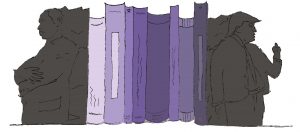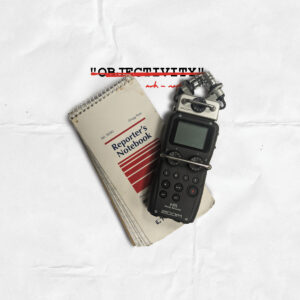Olivia Francis-Anspach (COL ’21) rarely reads campus news outlets anymore. “I don’t see myself in campus publications. I don’t see myself represented there,” Francis-Anspach said. “I came in freshman year reading The Hoya and I was like, ‘okay, like, this is cool. I really like to read what’s going on.’ And then I was like, ‘oh, this is really disheartening.’”
Tired of waiting to see her own stories on the page, Francis-Anspach partnered with nine other students to revive the Blaxa, a student publication which aims to offer news, art, and commentary relevant to Georgetown’s black community. The Blaxa initially launched in 2018, but was unable to find its footing on campus. Now the Blaxa is returning in 2020, and its organizers hope to build a journalistic space for black students that will outlast their time on campus and tell their stories on their own terms.
The Blaxa’s board believes campus media fails to accurately reflect the experiences of black students. When the Blaxa’s editor-in-chief Monique Wilson (COL ’22) scrolls through Georgetown’s news coverage, she sees black issues boiled down to a few of the biggest stories.
“I feel like a lot of the articles that I’ve seen from publications on campus, when they do talk about black people or represent black voices, they’re usually only opinion pieces, or they’re only about GU272 or something that’s very visibly black,” Wilson said. “Whereas what we want to do is have any type of story and have regular black themes be represented. Black people don’t just talk about, like, slavery all day.”
Journalism’s poor representation of black experiences extends far beyond Georgetown’s front gates. Campus news outlets mirror a trend of racial disparity in newsrooms across the country. In a 2018 survey, the American Society of News Editors (ASNE) found that nearly all American newsrooms are whiter than the cities they serve. The Washington Post and The Boston Globe were both found to be below racial parity, and the ASNE listed The Los Angeles Times as 25 points over-represented by white staffers.
ASNE’s survey also shows the numbers have failed to improve over time. Since 2001, they found that only 40 percent of newsrooms gained racial diversity, and 16 percent actually lost diversity. In most surveyed newsrooms, the disparity exists in top roles too: more than 75 percent of leadership is white.
This lack of diversity is often reflected in the attitude newsrooms take towards covering racial issues. The past few years alone have seen a string of journalists of color punished for commenting on issues of racial inequality. Ryon Henderson (MSB ’22), the Blaxa’s director of strategy, pointed to black journalist Jemele Hill, who was suspended from ESPN in August 2018 for calling President Donald Trump “a white supremacist” as an example of newsrooms ostracizing black reporters. Henderson believes Hill intimidated ESPN by refusing to prioritize ratings over her voice.
“When you have a Jemele Hill who’s connecting intersections of sports, race, and culture, you’re like, ‘wait a second, this is alienating some of our viewers, and it’s not promoting the narrative that we want to promote.’ And so they immediately blackball her because she doesn’t fit that narrative,” Henderson said.
Hill is hardly the only reporter to face backlash for addressing racial issues. On Feb. 3, the Daily Beast reported that Wesley Lowery, a former Washington Post reporter, was chastised by management for his criticism of a New York Times article he felt did not adequately address racism in its coverage of the Tea Party.
Ashanti Callender (MSB ’21), the Blaxa’s director of external affairs, thinks the press is often hesitant to address issues of race. “People don’t like to have conversations where they will be uncomfortable. I feel like this country in general, especially in journalism, does not like to talk about this country’s history.”
Francis-Anspach sees a similar failure of diversity in campus media, and points to a larger trend amongst student groups at Georgetown. According to Georgetown’s 2018-2019 Common Data Set, there are 484 undergraduates who identify as black or African American out of 7,459 students on campus, or about 6.5 percent of the school’s undergraduate population. Organizations, Francis-Anspach said, often look to their members of color to draw in their non-white peers. “‘How do we get our membership to be more diverse?’ Every board that isn’t a black board, they all have that conversation. Everybody’s always asking that question,” she said. “They’re looking at the people of color, like ‘why aren’t you all here?’ As if it’s an us problem.”
In the Blaxa, black students will call the shots. The group’s mission statement promises to “provide critical perspectives, with respect to the intersection of race, socioeconomic status, gender identity, sexual orientation, nationality, immigration status, and ability,” the mission statement reads. “The Blaxa aims to be the go-to publication for black students where they know blackness will always be centered.”
The Blaxa published the first article on its website in September 2018, a piece titled “Pick your playlists carefully; they mean more than you think,” which explores the way party playlists can reflect the target audience of an event. It’s the kind of story that exemplifies the Blaxa’s goal—to make the black experience the lens through which campus life is viewed.
The group continued to publish a handful of articles, including an analysis of lobbying against 2018’s Initiative 77, a repealed initiative that aimed to eliminate minimum wage exemptions for tipped workers, and a profile of a student who advocated for solutions to campus food insecurity. Many of the students involved in the Blaxa’s founding graduated, and by November, it had been more than six months since an article had been published to their website.
Bryce Badger (MSB ’21), the Blaxa’s CEO and president, didn’t want the Blaxa to disappear and began an effort to revive the publication. “I felt like there was a need for black voices on campus,” Badger said. “And so I really like the idea of a black space for us to express our perspectives and tell our stories.”
Georgetown saw a flurry of national media activity in 2019 as students voted in the GU272 referendum to create a reconciliation contribution for descendants of slaves sold by the university. While the Blaxa will certainly cover the big news events on campus, they also want to give their writers an opportunity to report on all aspects of the black community, not just the major headlines.
“I think when I see blackness on TV, it’s usually a really big grand event or something super catastrophic,” said Jamia Ross (NHS ’21), the Blaxa’s director of creative communications and marketing. “But I think the Blaxa is going to be a space where it’s normal essentially. It’s for everybody.”
For Jeremiah Hakimiah (MSB ’23), the Blaxa’s director of strategic communications and marketing, the core issue with other campus publications is they approach issues from a perspective that treats whiteness as the standard. He says he rarely reads the news, on campus or off, and he believes he’s not alone in his decision to avoid the headlines.
“News sources just really don’t package information or deliver arts or news or opinions in a way that is really understandable and resonates with black people,” Hakimiah said. “Not to diss the Voice or The Hoya or anything, but I don’t think I would give a shit really what you have to say because I know that it’s not gonna be said in a way or packaged in a way or said by people who really resonate with me or have my culture.”
The Washington Informer, a black-run outlet based in Southeast D.C., tries to fill in these gaps in the city, aiming to cover black issues across the District in day-to-day life. Denise Rolark Barnes, the Informer’s publisher, pointed out that other papers have different sections covering everything from sports to culture to hard news. The Informer, she says, is no different. While the paper does occasionally cover issues like reparations or police brutality, it also aims to address the everyday concerns of the black community.
“Other publications document life,” Barnes said. “For us, we have a publication that focuses on our community all the time. One thing we always say is that 50 to 100 years from now, when people want to see what was going on in the black community, they have to come to us.”
Today, the Chicago Defender, the Challenger, and the Michigan Chronicle are just a few papers serving the black community. In addition to the Informer, the Afro-American also serves the black community in the District.
Sam P.K. Collins began the Black ACE Magazine at George Washington University in 2008. He now works for the Informer and believes the lack of diversity in mainstream media outlets makes the black press the most trustworthy way to address black issues. “My question is why are we depending on them to tell our stories?” Collins said. “I can’t expect people who don’t look like me to give enough context to my suffering. If you give it to the black press there’s much more context.”
The history of black-run publications goes back almost 200 years. In 1827, John Russwurm and Samuel Cornish began Freedom’s Journal, a New York paper covering not only hard news, but also issues of slavery, abolition, and the Back-to-Africa movement, which encouraged free black Americans to emigrate to Africa. Founded to counteract racist ideology in the mainstream press, Freedom’s Journal also served as a paper of record, offering birth records, marriage announcements, and obituaries of figures within the black community.
Freedom’s Journal would only last two years due to an ideological split between Russwurm and Cornish over the Back-to-Africa movement, but their work inspired a generation of black publications. When the Civil War broke out in 1861, at least 40 black publications were circulating around the country. Journalists like Ida B. Wells, who detailed the grim reality of lynching in the South during the Jim Crow era, and W.E.B. Du Bois, the civil rights advocate and writer who founded the NAACP’s magazine The Crisis, built their own platforms when other media avenues were not accessible to them.
Collins sees these figures as a combination of advocates and journalists. “People think that you write the news, and after that the problem’s over. The news is a tool to galvanize the public,” Collins said. “They were really critical in using the print media to galvanize black people around issues.”
The Blaxa’s board understands that like their predecessors in black press, the publication can be more than just a news source. In five years, Callender envisions the Blaxa as a way to draw more diverse perspectives to Georgetown, especially those who might not have seen themselves fitting in before. “We’ll be a media presence that even when kids are looking up at colleges, they’re like ‘Oh, hey, I didn’t even think that Georgetown was an option.’”
With that future in mind, the leadership team of the Blaxa has begun recruiting writers and working through the new club development process. They hope to publish in print once per semester and more regularly online, with a launch event slated for April 25. The process has already been complicated: Francis-Anspach departed the board in February, citing time concerns, but right now, the board is most concerned with filling their pages.
Wilson, in her role as editor-in-chief, hopes that the Blaxa will be able to build a team unified by a sense of purpose. “If we don’t write our stories, then no one else will and no one will do it to the measure that we would like to do.”




